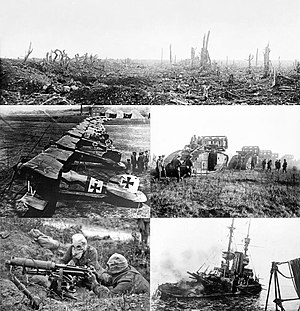User:Katthecat666/sandbox
| Submission declined on 3 November 2023 by CNMall41 (talk). This submission provides insufficient context for those unfamiliar with the subject matter. Please see the guide to writing better articles for information on how to better format your submission.
Where to get help
How to improve a draft
You can also browse Wikipedia:Featured articles and Wikipedia:Good articles to find examples of Wikipedia's best writing on topics similar to your proposed article. Improving your odds of a speedy review To improve your odds of a faster review, tag your draft with relevant WikiProject tags using the button below. This will let reviewers know a new draft has been submitted in their area of interest. For instance, if you wrote about a female astronomer, you would want to add the Biography, Astronomy, and Women scientists tags. Editor resources
|  |
| Second Great War | |||||||
|---|---|---|---|---|---|---|---|
 Clockwise from the top left: Dutch soldiers posing after the Battle of East Anglia; British colonial troops during the Nigeria campaign; German Fallschirmjäger in the only airborne operation of the war, the Battle of Frankfurt; What remained of the local terrain after the Battles of Amiens; A P-26 Peashooter, as part of the American Expeditonary Force, Europe | |||||||
| |||||||
| Belligerents | |||||||
|
| |||||||
| Commanders and leaders | |||||||
|
Main Allied leaders |
Main Tripartite and Comintern leaders | ||||||
| Strength | |||||||
|
| ||||||
| Casualties and losses | |||||||
|
| ||||||
| Second World War | |||||||
|---|---|---|---|---|---|---|---|
 Clockwise from the top left: Tank Commander of the 6th Afrika Panzer Division during the Egypt Campaign; The Japanese carrier Hiryū; Australian guerrillas, approximately 3 weeks before the 4th Army arrived in Australia to crush resistance; Italian P.108 bomber over the Atlantic on a bombing run on Norfolk; US soldiers as part of the Allied Africa Expeditionary Force; Trapped Indian soldiers 104 days into the Siege of Dacca | |||||||
| |||||||
| Belligerents | |||||||
|
Allies
|
Tripartite Pact | ||||||
| Commanders and leaders | |||||||
|
Main Allied leaders |
Main Tripartite and Comintern leaders | ||||||
| Strength | |||||||
|
| ||||||
| Casualties and losses | |||||||
|
| ||||||
| First Weltkreig | |||||||
|---|---|---|---|---|---|---|---|
 Clockwise from the top: Captured British soldiers after the Battle of Hull; German soldiers advancing during the Battle of Warsaw; The SMS Wein, 3 days before it is sunk in the Battle of the Channel; Japanese troops invading German Indochina; a Swiss trench, one of the most advanced designs of the war. | |||||||
| |||||||
| Belligerents | |||||||
|
|
Allied Powers | ||||||
| Commanders and leaders | |||||||
|
|
| ||||||
| Strength | |||||||
| Total: 14,400,000 |
| ||||||
| Casualties and losses | |||||||
|
|
| ||||||
